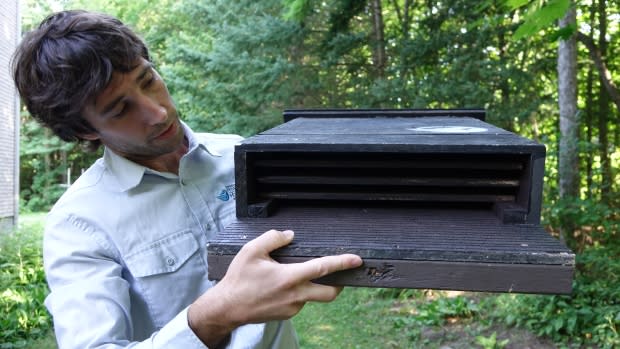Researchers aim to build a better bat house
Wildlife experts have launched the first study of its kind in Canada to find out where bats go after they've been evicted by humans, and whether they'll settle for a man-made shelter.
Canada's bat population is already in decline due to loss of habitat, pesticides and the steady spread of white-nose syndrome, according to the Canadian Wildlife Federation (CWF).
So when homeowners force bats from their cozy quarters in attics and chimneys, scientists want to know what happens to them next in a bid to protect the remaining population.
The recent discovery of a colony of 104 bats in the attic of a home in the south Ottawa suburb of Manotick provided the perfect opportunity.

Bats to be tagged
On Saturday, before the bats are evicted through a one-way door, researchers will tag six of the bats in order to track their post-eviction flight path.
"It's understandable that nobody wants to have 100 bats in their attic," said James Pagé, a specialist in species at risk and biodiversity with the CWF. "We are here ... to give them a new place to stay."
Researchers will attach nickel-sized radio transmitters to the six bats to track them over the next few weeks. They're eager to see whether the animals will simply swoop back to their old haunt, or try out a specially designed bat house instead.
There are currently 150 of the wooden shelters atop homes across Ottawa as part of the project, which began in 2017 to determine the best bat house design.

Choosing best design
Homeowners have been asked to track bat sightings to determine which of the three bat house designs is most popular.
"We're trying to figure out if there's one design they prefer over another, and if so, we can focus on just promoting that design," Pagé said.
Where the Manotick bats end up may also depend on their species. Eight of the 19 bat species found in Canada call Ottawa home, and if the ones from the Manotick attic turn out to be of the "big brown" variety, as Pagé suspects, they'll likely try to return to the attic.
If they do, they'll find a brand new bat house, and researchers will be keen to see whether they like it.
"We want to know what [eviction] does to the bats," Pagé said. "Do they go to another area? Do they try and get back and just hang out on the side of the house?"


